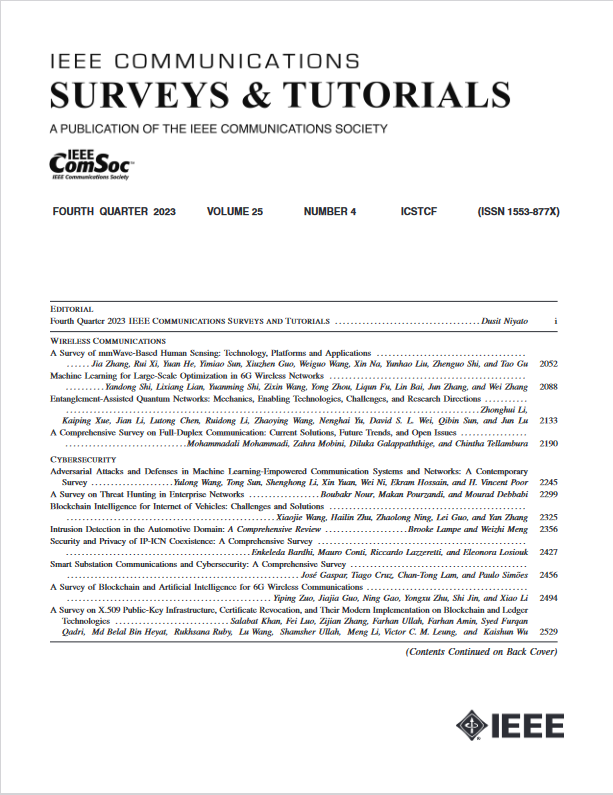Machine Learning for Healthcare Radars: Recent Progresses in Human Vital Sign Measurement and Activity Recognition
IF 34.4
1区 计算机科学
Q1 COMPUTER SCIENCE, INFORMATION SYSTEMS
引用次数: 0
Abstract
The unprecedented non-contact, non-invasive, and privacy-preserving nature of radar sensors has enabled various healthcare applications, including vital sign monitoring, fall detection, gait analysis, activity recognition, fitness evaluation, and sleep monitoring. Machine learning (ML) is revolutionizing every domain, with radar-based healthcare being no exception. Progress in the field of healthcare radars and ML is complementing the existing radar-based healthcare industry. This article provides an overview of ML usage for two major healthcare applications: vital sign monitoring and activity recognition. Vital sign monitoring is the most promising healthcare application of radar, as it can predict several chronic cardiac and respiratory diseases. Activity recognition is also a prominent application since the inability to perform activities may result in critical suffering. The article presents an overview of commercial radars, radar hardware, and historical progress of healthcare radars, followed by the usage of ML for healthcare radars. Subsequently, the paper discusses how ML can overcome the limitations of conventional radar data processing chains for healthcare radars. The article also touches upon recent generative ML concepts used in healthcare radars. Among several interesting findings, it was discovered that ML does not completely replace existing vital sign monitoring algorithms; rather, ML is deployed to overcome the limitations of traditional algorithms. On the other hand, activity recognition always relies on ML approaches. The most widely used algorithms for both applications are Convolutional Neural Network (CNN) followed by Support Vector Machine (SVM). Generative AI has the capability to augment data and is expected to have a significant impact soon. Recent trends, lessons learned from these trends, and future directions for both healthcare applications are presented in detail. Finally, the future work section discusses a wide range of healthcare topics for humans, ranging from neonates to elderly individuals.医疗雷达的机器学习:人体生命体征测量和活动识别的最新进展
雷达传感器具有前所未有的非接触、非侵入和保护隐私的特性,使各种医疗保健应用成为可能,包括生命体征监测、跌倒检测、步态分析、活动识别、体能评估和睡眠监测。机器学习(ML)正在彻底改变各个领域,基于雷达的医疗保健领域也不例外。医疗雷达和 ML 领域的进步正在补充现有的雷达医疗行业。本文概述了 ML 在生命体征监测和活动识别这两大医疗应用中的应用。生命体征监测是雷达最有前途的医疗应用,因为它可以预测多种慢性心脏病和呼吸系统疾病。活动识别也是一个突出的应用,因为无法进行活动可能会导致严重的痛苦。文章概述了商用雷达、雷达硬件和医疗雷达的历史进展,然后介绍了 ML 在医疗雷达中的应用。随后,文章讨论了 ML 如何克服医疗雷达传统雷达数据处理链的局限性。文章还谈到了最近用于医疗雷达的生成式 ML 概念。在几个有趣的发现中,我们发现 ML 并不能完全取代现有的生命体征监测算法;相反,部署 ML 是为了克服传统算法的局限性。另一方面,活动识别始终依赖于 ML 方法。这两种应用中最广泛使用的算法是卷积神经网络(CNN),其次是支持向量机(SVM)。生成式人工智能具有增强数据的能力,预计不久将产生重大影响。本文详细介绍了这两种医疗应用的最新趋势、从这些趋势中吸取的经验教训以及未来发展方向。最后,未来工作部分讨论了从新生儿到老年人的各种人类医疗保健主题。
本文章由计算机程序翻译,如有差异,请以英文原文为准。
求助全文
约1分钟内获得全文
求助全文
来源期刊

IEEE Communications Surveys and Tutorials
COMPUTER SCIENCE, INFORMATION SYSTEMS-TELECOMMUNICATIONS
CiteScore
80.20
自引率
2.50%
发文量
84
审稿时长
6 months
期刊介绍:
IEEE Communications Surveys & Tutorials is an online journal published by the IEEE Communications Society for tutorials and surveys covering all aspects of the communications field. Telecommunications technology is progressing at a rapid pace, and the IEEE Communications Society is committed to providing researchers and other professionals the information and tools to stay abreast. IEEE Communications Surveys and Tutorials focuses on integrating and adding understanding to the existing literature on communications, putting results in context. Whether searching for in-depth information about a familiar area or an introduction into a new area, IEEE Communications Surveys & Tutorials aims to be the premier source of peer-reviewed, comprehensive tutorials and surveys, and pointers to further sources. IEEE Communications Surveys & Tutorials publishes only articles exclusively written for IEEE Communications Surveys & Tutorials and go through a rigorous review process before their publication in the quarterly issues.
A tutorial article in the IEEE Communications Surveys & Tutorials should be designed to help the reader to become familiar with and learn something specific about a chosen topic. In contrast, the term survey, as applied here, is defined to mean a survey of the literature. A survey article in IEEE Communications Surveys & Tutorials should provide a comprehensive review of developments in a selected area, covering its development from its inception to its current state and beyond, and illustrating its development through liberal citations from the literature. Both tutorials and surveys should be tutorial in nature and should be written in a style comprehensible to readers outside the specialty of the article.
 求助内容:
求助内容: 应助结果提醒方式:
应助结果提醒方式:


